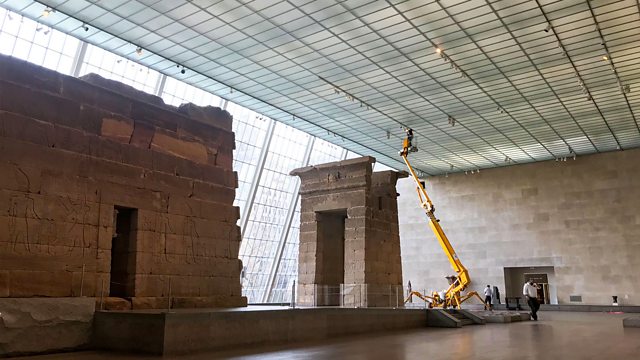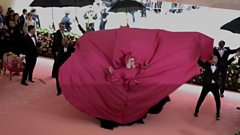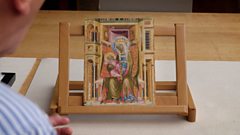
Episode 3
With a cash crisis, restrictions on visitor numbers and exhibitions, a new roof to pay for, and an imminent election causing alarm, friends and donors rally round to save the Met.
Autumn, 2020. The Met is open, but in a safe and very limited way. Visitor income helps keep the museum running, so times are hard. Since it was founded, like so many US arts institutions, the Metropolitan has largely been funded by benefactors. We visit Clyde B Jones III, the executive matching modern donors to exhibitions and events as the economy tanks.
Jones explains how hard it is to keep up the social links that the system depends on. He has, nonetheless, found it possible to drum up millions of dollars for the imminent remodelling of the Arts of Africa, Oceania and the Americas galleries. Currently, the need to shade the massive south-facing glass wall that illuminates the rooms means artefacts are not shown to their best advantage. Now he must find the funds to replace those walls.
Some give money, but others donate items from their own collections. We meet curator Jaysen Dobney of the musical instruments department as a rock musician and long-term patron asks for help with his problem, a collection of 403 guitars. Dobney is only too happy to have a promised gift of a 60s Gibson Les Paul TV Special.
Every department is currently calling on its supporters. In Textile Conservation, Head Curator Janina Poskrobko makes breakfast for a visiting professor. We've been with her since dawn, at home in Staten island, saying her prayers. She must find the money for an unfunded project - the rescue of an Ottoman robe. We observe as she subtly raises the issue while showing him a Renaissance cape. The professor is a textile expert and passionate supporter. Might he dig deep?
The Costume Institute is normally funded by stars who pay to attend the famous Met Gala fashion event, but this year they're economising. The 2020 Ball is cancelled, so 2019's proceeds must be used carefully. We follow the building of About Time as the set undergoes construction and the garments are installed.
Meanwhile, fashionable friends are stepping up. In Detroit, America's most flamboyant private collector of couture, Sandy Shrier, opens her home, and her heart, to explain why the Met is so important to her - and why last year she donated 160 garments amassed over seven decades of collecting.
In London, we are with top-end cobbler Georgina Goodman, who has just taken a call from the Met, asking for help bolstering their huge accessories archive. In the mid-2000s, Goodman attracted the attention of couturier Alexander McQueen. Packing up her sketches, the designer reveals how she was charged with interpreting Lee McQueen's footwear visions, including the iconic armadillo shoe. The Met has a pair, but is keen to acquire Goodman's original sketches.
As Covid keeps visitor numbers low, every ticket purchased helps keep the lights on and the building open. With no tourist trade, the Met is back to where it began in 1870, catering for locals. Citizens are not obliged to pay for entry into the museum, but Naqiya Hussein has bought two tickets. She's joining the many young people, newly unlocked but making only tentative outings, on a Met Date. Her scientist beau Cyril and she enjoy the tranquillity of solitude in her favourite galleries, though the camera is ever present. A date here is a litmus test of love. If the million objects on display can't spark a conversation, it's never going to work.
Perhaps the greatest donation is a lifetime of work at the Met - or the possibility at least. We are with Vietnamese-American student Kevin Pham as he visits the medieval department at the Met Cloisters in northern Manhattan. He's one of 120 postgraduate interns, paid through a new $5M donation to study with a view to a possible career in the museum. The Met wants to build a new and diverse staff, and must succeed if it is to remain relevant. As Kevin says, the museum can't be the preserve of bearded old white men.
At Halloween, About Time opens. The annual Costume Institute show is always a blockbuster that draws in the crowds, and now the stakes are high. The newly reopened Met must show that it is still the place for fashion as art. This anniversary year, a mirrored gallery, packed with black garments from across 150 years, points to objects that are timeless in an industry now driven by constant change. We're with fashionistas as they thrill to the show, noting that even on a budget, Curator Andrew Bolton has managed to make a splash.
Philanthropy has always kept the Met alive and vibrant, and as the nights draw in, there's disquiet about the upcoming US election and its effect on giving. A change of administration, or the return of President Trump, might warp the delicate web of tax breaks and write-offs that underpin the whole arts world. With the fall-out of Covid and the tumult of Black Lives Matter in mind, CEO Dan Weiss gives a dark assessment of America's contribution to history. And on the night of the election itself, Head of Communications Ken Weine worries about money, staff and the fate of culture itself.
Last on
More episodes
Previous
Next
You are at the last episode
See all episodes from Inside America's Treasure House: The Met
Clips
-
![]()
About Time - A fashion exhibition without the annual Gala
Duration: 01:36
-
![]()
Creating a legacy
Duration: 01:47
Music Played
-
![]()
Anthony Phillips
Gravity Ride
-
![]()
Koka Media
Prelude A L'apres Midi D'un Faune



